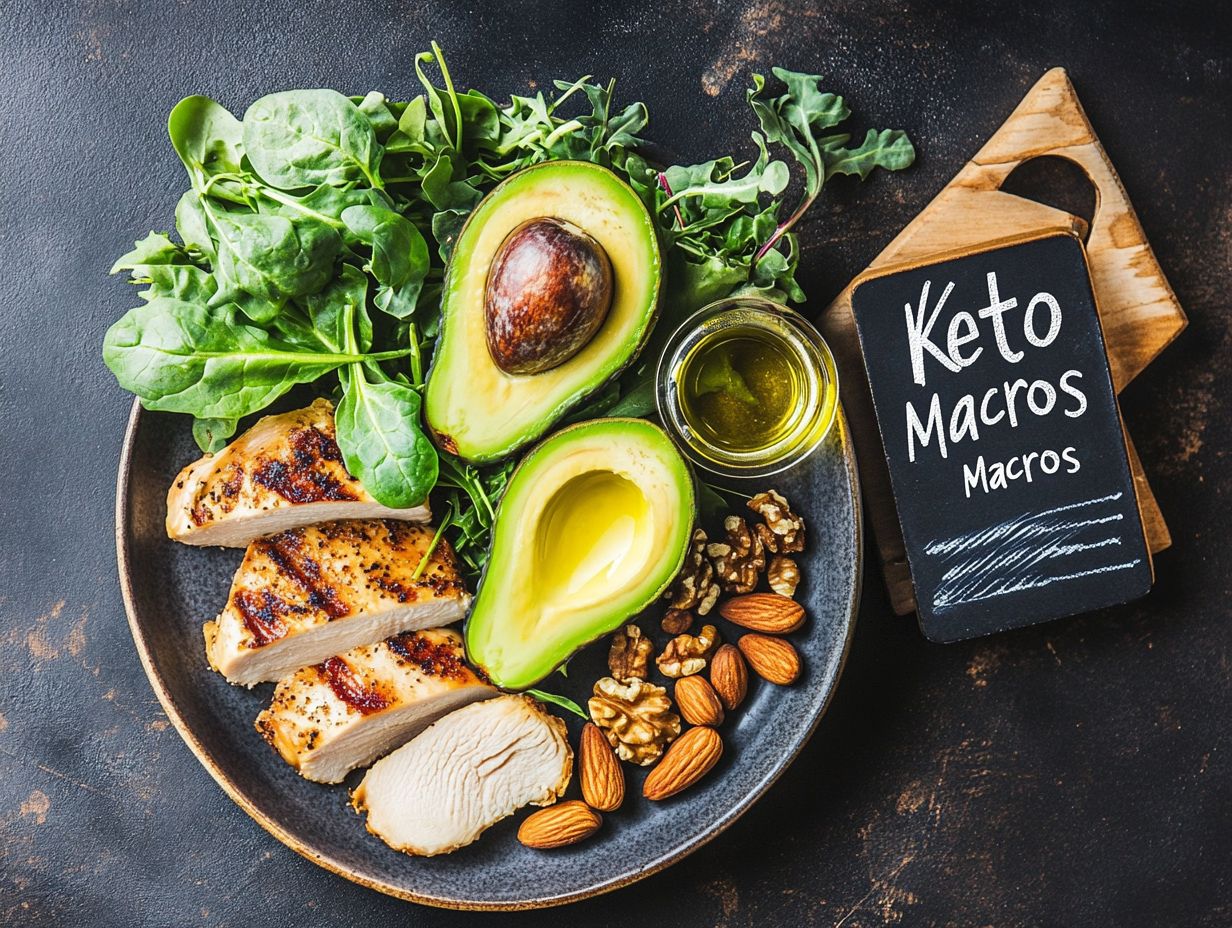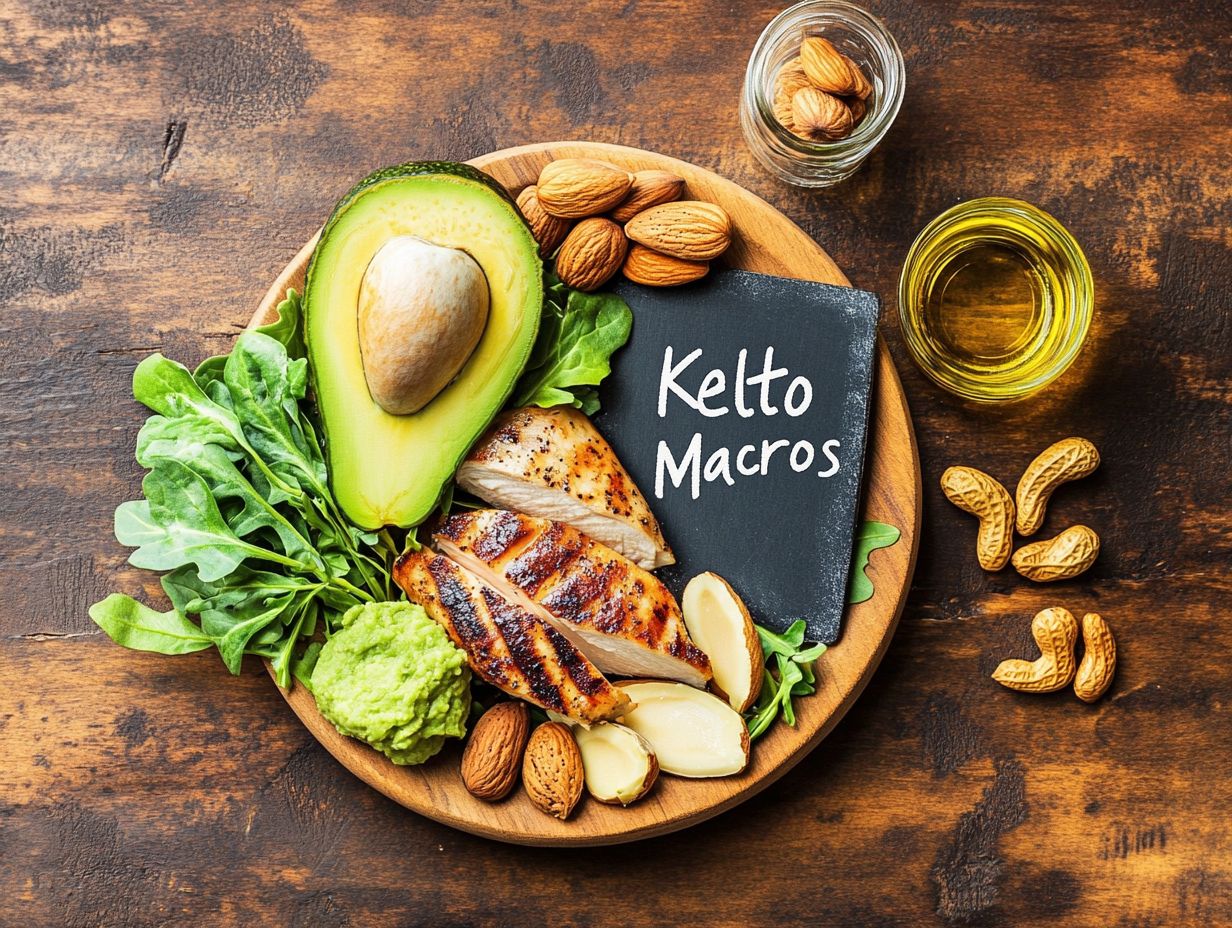What are Keto Macros? Your Questions Answered
Navigating the ketogenic diet can feel like a daunting task, especially when it comes to grasping the intricacies of keto macros and utilizing a keto calculator. These vital components fats, proteins, and carbohydrates are essential for achieving and maintaining ketosis, the metabolic state that ignites fat burning.
This guide equips you with everything you need to know about keto macros, detailing their significance, how to calculate them using a macronutrient calculator, the best apps for tracking your intake, and the common pitfalls you should steer clear of. Whether your goal is weight loss, muscle gain, or simply embracing a healthier lifestyle, mastering your keto macros is the cornerstone of your success.
Contents
- Key Takeaways:
- What Are Keto Macros?
- Why Are Keto Macros Important?
- How Do You Calculate Keto Macros?
- How Do You Track Keto Macros?
- What Are the Benefits of Tracking Keto Macros?
- What Are the Common Mistakes When Tracking Keto Macros?
- 1. Not Accounting for Hidden Carbohydrates
- 2. Not Adjusting Macros for Individual Needs
- 3. Not Considering Nutrient Density
- How Do You Adjust Keto Macros for Different Goals?
- Frequently Asked Questions
- Keto Macros: Why They Matter
Key Takeaways:

- Keto macros are the specific amounts of fat, protein, and carbohydrates to consume on a ketogenic diet.
- Tracking keto macros helps achieve and maintain ketosis and aids in weight loss.
- Common mistakes when tracking include not accounting for hidden carbs and nutrient density.
What Are Keto Macros?
Keto macros represent the precise ratios of fats, proteins, and carbohydrates that you consume on a ketogenic diet to manage your metabolic state. This low-carb, high-fat approach is designed to induce ketosis, a metabolic state where your body shifts to using fat as its primary energy source instead of carbohydrates.
Understanding these keto macros is crucial for managing your protein intake and body fat percentage. It will help you successfully reach your weight loss goals while following dietary guidelines that highlight the nutritional value of your food choices.
By meticulously tracking these macros, you can optimize your ketogenic journey for effective fat loss. This also helps with appetite and energy management.
Why Are Keto Macros Important?
Keto macros are essential because they directly affect your metabolic state of ketosis, enabling your body to efficiently burn fat for energy instead of relying on carbohydrates. By sticking to the recommended macronutrient ratios, you can optimize your protein intake and manage your body weight.
Maintaining the right macro ratios significantly influences appetite regulation, leading to reduced hunger and making it easier for you to adhere to a ketogenic lifestyle. For instance, a study published in the ‘American Journal of Clinical Nutrition’ found that individuals who monitored their macronutrient intake had a more balanced insulin response and sustained energy levels throughout the day.
Tracking your macros enables you to make smarter dietary choices, enhancing not just weight loss but also your overall well-being. This balanced approach supports you in reaching your specific health goals and fosters long-term, sustainable habits that contribute to a healthier lifestyle.
How Do You Calculate Keto Macros?
Ready to take control of your keto journey? Start by calculating your Total Daily Energy Expenditure (TDEE) or using methods like the Katch-McCardle Formula or Harris-Benedict Formula. You can utilize formulas such as the Mifflin-St. Jeor Formula, which takes into account your body weight, activity level, and metabolic factors to establish a personalized caloric target.
Once you have that figure, you can define your macronutrient ratios typically a high-fat, moderate-protein, and low-carb approach, adjusting for your activity level and nutritional needs. This strategy allows you to create a calorie deficit for effective weight loss while still ensuring you meet your nutritional needs.
What Are the Recommended Keto Macro Ratios?
The recommended keto macro ratios typically suggest around 70-75% fat, 20-25% protein, and 5-10% net carbs. These ratios help manage your insulin response and promote ketone production. Following these guidelines can help you achieve a state of ketosis while meeting your individual weight loss goals.
However, these ratios may need some tweaking based on personal factors like your activity level and body composition. It s essential to tailor them to your specific needs and preferences to optimize your results.
By sticking to these macronutrient ratios, you can effectively boost ketone production, your body s alternative energy source made from fat. This process helps manage your appetite, reduces cravings, and enhances satiety while aligning with your fitness objectives.
For instance, if you re focused on maintaining muscle, you might want to increase your protein intake within the recommended range. Think chicken, fish, and eggs. On the flip side, if fat loss is your goal, prioritizing healthy fats like avocado, olive oil, and nuts while keeping your carb intake low could work wonders.
Each adjustment ensures that your diet remains sustainable and aligned with your desired outcomes, making the keto approach both flexible and effective for energy release and overall well-being.
How Do You Track Keto Macros?
Tracking your keto macros effectively requires leveraging tools like calorie tracking apps, such as MyFitnessPal or Cronometer. These tools help you keep a close eye on your intake of carbohydrates, fats, and proteins, and manage your total daily energy expenditure (TDEE). This ensures you remain within your specified macronutrient ratios.
By carefully examining nutritional labels and recognizing your daily fiber requirements, you can make informed decisions about your meals an essential practice for thriving on a ketogenic diet and ensuring balanced macronutrient intake.
What Are the Best Apps for Tracking Keto Macros?

Regarding tracking your keto macros, MyFitnessPal and Cronometer are the cr me de la cr me. They shine with their user-friendly interfaces, extensive food databases, and robust nutritional value tracking capabilities. This allows you to effortlessly log your meals and monitor your macro ratios.
These apps also help you track your fiber intake and overall calorie consumption, as well as understand the carb content of various foods, making them essential tools for anyone on a ketogenic diet.
Both platforms cater to a wide array of dietary needs with personalized settings that simplify your journey toward achieving your goals, including features for meal planning and tracking body weight. MyFitnessPal truly excels with its social networking features, letting you connect with friends for motivation and share your progress.
On the other hand, Cronometer goes above and beyond with detailed micronutrient tracking, ensuring that you meet all your nutritional requirements while adhering to your keto plan.
Countless users are thrilled with their impressive weight loss results, boosted energy levels, and improved overall health by leveraging these apps. This demonstrates just how effective technology can be in your dietary journey, including preventing weight gain.
What Are the Benefits of Tracking Keto Macros?
Tracking your keto macros offers an array of advantages, such as improved weight loss results, enhanced health benefits, and superior appetite management. This practice enables you to stay aligned with your dietary goals while optimizing your macronutrient intake.
By maintaining a sharp awareness of your food choices and their nutritional values, you can ensure that you are fueling your body effectively for energy release and overall well-being.
Start tracking your macros today and experience the benefits for yourself!
1. Helps Achieve and Maintain Ketosis
Tracking your keto macros helps you reach and sustain ketosis. This metabolic state allows your body to shift from carbohydrates to fats for energy, helping you maintain lean body mass.
This transition is vital for anyone on a ketogenic diet, as it optimizes fat loss and ensures a consistent release of energy throughout your day. To effectively navigate this shift, you’ll need to fine-tune your macronutrient ratios, typically targeting a diet rich in fats, moderate in proteins, and extremely low in carbohydrates.
The ideal macro ratio often sits at around 70-75% fat, 20-25% protein, and 5-10% carbohydrates. Keeping your carbohydrate intake low is crucial, as it helps deplete glycogen stores and encourages your body to enter ketosis more efficiently.
By diligently tracking your food intake, you gain valuable insight and maintain compliance. This ensures that your body stays in this fat-burning mode while steering clear of any unintended detours from your plan, effectively managing your protein and fiber intake.
2. Aids in Weight Loss
Tracking your keto macros can be a game changer in your journey towards weight loss, helping you maintain a calorie deficit that’s essential for shedding fat while preventing metabolic damage.
By diligently logging your calorie intake and sticking to your chosen macronutrient ratios, you can fine-tune your dietary approach to achieve effective weight management and prevent unnecessary weight gain.
This method not only raises your awareness of what you re consuming but also encourages you to make more thoughtful food choices. You might find that adjusting your intake based on your progress whether that means dialing back on carbohydrates or ramping up healthy fats can lead to results that are tailored specifically to your needs.
Success stories highlight the amazing transformations that come from macro tracking! People have shed pounds and reshaped their bodies while keeping muscle mass intact. Research backs this up too, revealing that those who keep an eye on their macros often achieve their fitness goals more effectively than those who don t.
3. Provides Insight into Eating Habits
Tracking your keto macros offers invaluable insights into your eating habits, unveiling the patterns in your food choices and their nutritional value that can guide you toward healthier decisions.
By understanding how different foods contribute to your overall calorie intake and macronutrient balance, you can adjust your diet to align with your health goals. Using tools like a keto calculator or macronutrient calculator can make this process easier.
This practice invites you to reflect deeply on your eating habits, illuminating areas that may require adjustment or enhancement. When you become aware of the specific foods fueling your body and how these choices correspond with your nutritional needs, you open the door to more mindful eating.
By utilizing macro tracking, you can pinpoint which meals effectively support your health objectives while discovering innovative ways to incorporate a broader array of nutrient-dense ingredients into your daily routine.
Ultimately, this heightened self-awareness leads to informed meal planning choices that promote healthier living, making your dietary journey both sustainable and enjoyable. Consider incorporating fiber intake to meet your daily fiber needs and manage your appetite.
What Are the Common Mistakes When Tracking Keto Macros?
As you embark on your journey of tracking keto macros, you may find yourself facing some common pitfalls that could impede your success. It s crucial to be mindful of hidden carbohydrates lurking in food sources, to tailor your macros to your individual needs, and to recognize the significance of nutrient density in your meals.
Using apps like MyFitnessPal or Cronometer can help in keeping track of your calorie consumption and macro ratios.
Overlooking these aspects can result in ineffective tracking, ultimately affecting your ability to reach your weight loss and health objectives. Regularly reviewing your body weight and body fat percentage can help in fine-tuning your approach.
1. Not Accounting for Hidden Carbohydrates

One of the most significant missteps in your journey to track keto macros is failing to account for hidden carbohydrates lurking in various food products. These sneaky carbs can derail your ketosis and negatively impact your weight loss efforts.
Many processed foods are guilty of hiding added sugars or high-carb ingredients. It s essential to scrutinize nutritional labels to uncover these hidden carbs. Pay close attention to their carb content and insulin response.
This level of vigilance can significantly enhance your ability to maintain a ketogenic lifestyle. As you scan labels, keep an eye out for terms like maltodextrin, dextrose, or even seemingly harmless fruit juices. They can quickly inflate your daily carb intake with unwanted additions. Carb tracking is essential to avoid these pitfalls.
Embracing whole foods like fresh vegetables and natural proteins helps you avoid hidden carbohydrates. It also boosts your overall nutrient intake.
Experimenting with low-carb alternatives like opting for cauliflower rice instead of traditional grains or swapping in zucchini noodles for pasta can keep your meals satisfying while supporting your dietary goals. These choices also aid in ketone production and help manage metabolic state.
2. Not Adjusting Macros for Individual Needs
Failing to adjust your macros to suit your individual needs is a common pitfall that can lead to less-than-stellar results on a ketogenic diet. Factors such as your activity level, body composition, and specific weight loss goals should dictate your macro ratios.
This ensures you receive adequate protein and achieve your desired outcomes. Use formulas like the Katch-McCardle Formula or Harris-Benedict Formula, which is a method for calculating your calorie needs, to get a personalized estimate.
To discover the right balance, consider using the Mifflin-St. Jeor formula, which provides a more precise estimate of your basal metabolic rate and caloric needs. You can also consider DEXA scans for precise measurements of lean body mass and body fat percentage.
By tailoring your macronutrient distribution to fit your lifestyle and objectives, you’ll find it easier to optimize your energy levels and maximize fat loss. Remember, it s equally important to periodically reassess these ratios, especially as you progress in your weight loss journey or as your fitness goals evolve.
Regular check-ins will help confirm that your chosen macro distribution remains effective. This allows you to adapt to new challenges without losing momentum. Adjusting protein ratios and fat intake as needed can help you meet evolving weight loss goals.
3. Not Considering Nutrient Density
Neglecting to consider nutrient density while tracking your keto macros can lead to poor food choices that may lack essential vitamins, minerals, and overall nutritional value, even if they fit within your macro ratios.
It’s crucial for you, as someone following a ketogenic diet, to prioritize nutrient-rich foods. These foods are not just good for your metabolic health; they also foster your overall well-being.
Emphasizing vegetables like leafy greens, broccoli, and cauliflower will provide you with essential fiber and antioxidants. Healthy fats from avocados, olive oil, and fatty fish like salmon deliver vital omega-3s that support brain function and muscle maintenance.
Incorporating low-carb nuts and seeds, which are packed with vitamins and minerals, can further enhance your nutrient intake. Make thoughtful food choices to enjoy the delicious flexibility of keto and nourish your body the way it deserves!
How Do You Adjust Keto Macros for Different Goals?
Adjusting your keto macros to suit different goals is crucial for aligning your dietary strategies with your personal objectives. Whether you’re aiming for weight loss, muscle gain, or maintenance, fine-tuning protein ratios and overall caloric intake is essential.
You can customize your ketogenic diet to effectively meet your specific health and fitness targets, ensuring that you fully support your desired outcomes. Tools like calorie tracking apps can help in this process.
Don t miss out on the opportunity to optimize your diet for your goals!
1. Weight Loss
To achieve weight loss, adjust your macros to create a calorie deficit. This typically means reducing your overall caloric intake while ensuring you maintain adequate protein to preserve muscle mass.
Using a macronutrient calculator can help you set the right targets. A common strategy is to lower your carbohydrate intake and increase your fat consumption, which helps keep your body in ketosis for optimal fat burning.
Start by calculating your Total Daily Energy Expenditure (TDEE), which is the total number of calories you burn in a day. Once you have your TDEE, aim for a calorie deficit of about 500 calories. This approach can lead to healthy and sustainable weight loss of roughly one pound per week. The Mifflin-St. Jeor Formula can help determine your TDEE accurately.
Monitor your progress regularly. You can do this weekly or bi-weekly. This practice helps you evaluate the effectiveness of your current macro ratios.
If you find your progress stalling, it might be time to make adjustments. Whether recalibrating your calorie target or tweaking your macro percentages, especially with carbohydrates and fats, you can stay on track toward reaching your weight loss goals.
2. Muscle Gain
If your aim is muscle gain, adjusting your macros focuses on achieving a calorie surplus. Ensure you have a high protein intake to support muscle maintenance and growth. This involves increasing your overall caloric intake with a balanced approach to fats and carbohydrates, providing the necessary fuel for your workouts and recovery.
To figure out your ideal calorie surplus, first determine your total daily energy expenditure (TDEE) based on your activity level, accounting for both workouts and daily movements. After establishing your TDEE, adding an additional 250-500 calories can create the right surplus to foster muscle gain.
If you’re following a ketogenic diet, focus on protein-rich foods like lean meats and dairy while keeping your fat intake higher. Adjusting your macro ratios to about 70% fat, 25% protein, and 5% carbohydrates can help optimize muscle growth.
Choose nutrient-dense, low-carb options like avocados, nuts, and leafy greens. Proper meal timing, such as enjoying protein-rich meals right after your workouts, will further enhance your muscle-building efforts. Also, managing fiber intake can aid in maintaining digestive health and nutrient absorption.
3. Maintenance

For maintenance, adjusting your macros requires finding that sweet spot to keep your weight stable. This typically involves calibrating your caloric intake to match your Total Daily Energy Expenditure (TDEE) while ensuring your protein intake supports muscle health and overall well-being.
Achieving this balance allows you to enjoy a diverse diet while still embracing the principles of a ketogenic lifestyle. Regularly monitor your body weight and make small adjustments to help maintain stability.
To navigate this transition effectively, periodically reassess your macro ratios and caloric needs to avoid unwanted weight fluctuations. Embrace flexibility in your meal planning, enabling a wider range of keto-friendly foods while prioritizing nutrient density.
Establishing a weekly meal prep schedule can be a game changer. This helps you stick to your macronutrient targets while simplifying grocery shopping and cooking.
Incorporating regular physical activity and practicing mindful eating habits can enhance your adherence to this lifestyle. Such practices provide the accountability and motivation needed to maintain your desired health outcomes. Use apps for calorie tracking and carb tracking to further streamline this process.
Frequently Asked Questions
What are Keto Macros?
Keto macros are the specific macronutrient ratios recommended for individuals following a ketogenic diet. These ratios typically consist of high fat, moderate protein, and low carbohydrate intake. They aim to optimize ketone production and maintain a steady metabolic state, supporting weight loss and muscle gain objectives.
Keto Macros: Why They Matter
Why are Keto Macros important?
Keto macros are important because they help ensure your body enters a state of ketosis, where it burns fat for energy instead of carbohydrates.
Following the recommended ratios can aid in weight loss, fat loss, and offer various health benefits. Proper protein and fiber intake also contribute to muscle maintenance and appetite management.
How do I calculate my Keto Macros?
Calculating your Keto Macros starts with determining your daily caloric needs. This includes your TDEE, which is the total amount of calories you burn in a day. Then, divide those calories between the recommended macronutrient balance for a ketogenic diet.
You can utilize tools such as a keto calculator, macronutrient calculator, or calorie tracking apps like MyFitnessPal or Cronometer to facilitate this process.
Additionally, methods like the Mifflin-St. Jeor Formula, Harris-Benedict Formula, and Katch-McCardle Formula can assist you in calculating your BMR (Basal Metabolic Rate) and caloric needs.
Do Keto Macros vary for everyone?
Yes, Keto Macros can vary for each individual based on factors like age, weight, body fat percentage, gender, activity level, and specific health goals. Make sure to find the right balance for your own body!
It’s essential to calculate your unique macros based on your personal needs and consider factors such as lean body mass and metabolic state.
Can I adjust my Keto Macros?
Absolutely! You can adjust your Keto Macros as needed. Some individuals may require changes to their macros as they progress on their ketogenic journey or as their goals evolve.
This might include aiming for muscle mass gain, weight gain, or weight loss. It’s crucial to regularly reassess and make adjustments to your macros, considering aspects like dietary fiber, net carbs, and overall calorie consumption.
What happens if I don’t follow my Keto Macros?
If you neglect to follow your Keto Macros, you may struggle to achieve your desired results or face negative side effects like fatigue, cravings, metabolic damage, and difficulties in maintaining ketosis.
You must stick to the recommended ratios to unlock all the amazing benefits of a ketogenic diet! Ignoring proper macronutrient ratios, including protein balance, fat intake, and carb tracking, can negatively affect ketone production, insulin response, and energy release.
Conclusion
In summary, understanding and correctly calculating your Keto Macros is vital for success on a ketogenic diet. Take the time to assess your personal needs, make necessary adjustments, and commit to following the recommended ratios. Your body will thank you!






